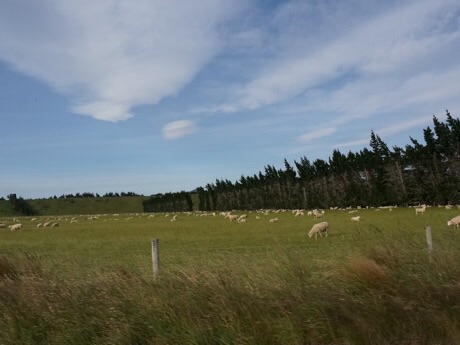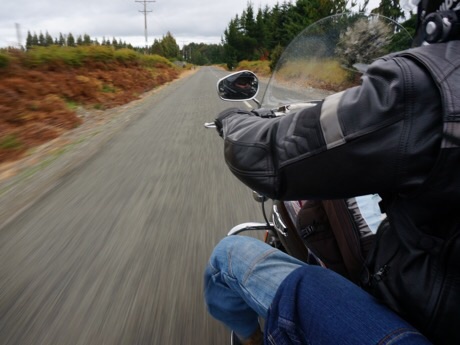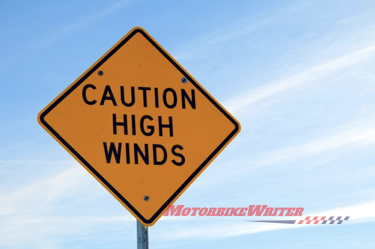One of the trickiest conditions to ride in is high wind, especially if the road is also wet.
High winds can be dangerous as they can blow your bike off course. They can also be tiring on a rider and just plain annoying.

Don’t go riding in gale-force winds on purpose. However, sometimes you simply get caught out by high winds, so you need to be prepared.
If there is one place in New Zealand that has consistently strong windy conditions, it’s Mossburn in the southern region of the South Island. We had to ride through the area twice, but fortunately, it is an isolated area of high wind and we were soon out of it.
Here are 10 tips for riding in high winds:

1 Be alert for tell-tale signs of the wind so you can judge which way it is blowing. Look at grass, the tops of trees, flags, windmills and birds. If they are blowing in one direction, you can set up for the blast, but if they are blustering back and forth, you are in for a battering. Places of high winds are typically open plains, valleys, mountain tops and beside large bodies of water. When you have assessed the conditions, you can set up your riding position for the oncoming blast.
2 If you have to go riding in the wind and you have a selection of bikes to take, select one that does not have bodywork, panniers, top box or a windscreen, unless it’s frame mounted. Bar-mounted windscreens and fairings will push the bike around in the wind. Heavy bikes with a low centre of gravity are better than lighter and tall.
3 In a headwind or tail wind, duck down and pin your arms and legs in. In a headwind, drop down a gear and accelerate smoothly into the wind to give you more control. In a tailwind, you may like to trail a bit of rear brake.
4 Crosswinds are trickier. You need to loosen up and not grip the handlebars with white knuckles. The bike is going to be blown around a bit, but you don’t need to choke it to retain control. Move forward in the seat and raise your elbows, motocross style. This gives better control of the steering.

5 A Kiwi motorcycle journalist gave me this tip that seems to work: If the wind is blowing from one side, hang the corresponding knee out. Somehow the wind will blow your leg about rather than the bike.
6 Blustery conditions are the most unpredictable. Ride slow and loose, elbows out, and be prepared to accelerate, lean and steer suddenly to regain control.
7 Give yourself margin for error. Ride in the middle of the lane and don’t aim for apexes as a sudden gust may blow you into oncoming traffic or off the side of the road.
8 Look out for protection from crosswinds, such as buildings, bushes, lines of trees, culverts and moving protection such as vans and trucks. If the wind is blowing from the side, you will be leaning the bike into the wind and when you enter the protection zone, the bike will suddenly tip further. Likewise, as you leave the protection, you will be blown the opposite way. In short protection zones, this can blow you one way and the other very quickly.
9 Take more frequent rests. Looking for the prevailing wind, setting up your riding position and reacting to being blown around takes it out of a rider, physically and mentally. You’ll need to take more breaks.
10 Check the weather warnings before you head off.


